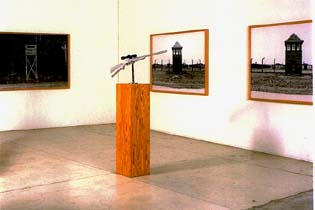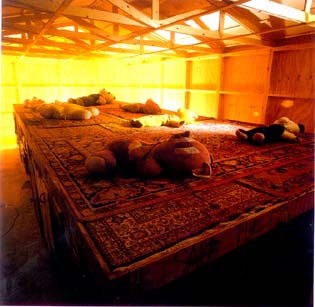
1999 Venice Biennial, from 13 May 1999 - The Israeli Delegation
Memory as History - History as Memory

The Artists:
Simcha Shirman  Born in Germany 1947, immigrated to Israel 1948. ( Photo Micha Kirshner )
Born in Germany 1947, immigrated to Israel 1948. ( Photo Micha Kirshner )
Philip Ranzer  Born in Rumania 1956, Immigrated to Israel 1961. ( Photo Micha Kirshner )
Born in Rumania 1956, Immigrated to Israel 1961. ( Photo Micha Kirshner )
The pavilion Curator:
Meir Ahronson  Curator and Director
of The Ramat Gan Museum for Israeli Art. ( Photo
M. Erez )
Curator and Director
of The Ramat Gan Museum for Israeli Art. ( Photo
M. Erez )
Memory as History, History as Memory
Venice 1999
Forward: From the catalogue by the curator,Mr. Meir Ahronson:
" I would like to unfold the reader, who has joined us on a journey to the end of the millennium through the works of the artists Simcha Shirman and Philip Ranzer, some of the problems I felt ought to be noted at this Biennale, which happened to be taking place at the close of the century and the millennium. This momentous, ponderous date obliges complex thought about both the essence of this biennale - is it a summery event? is it yet another immense exhibition? - and the essence of the Israeli art. I am about to present. It seems to me that, at present there is no point summarizing the 100 years of Israeli art. The picture is not clear; as yet, nothing has crystallized into a comprehensive, distinctly artistic statement that also speaks to the international art audience. That is form of strictly artistic standpoint, there is no sense trying to summarize " Israeli Art " just yet: Everything is too new, and lacks contour; it's still an internal affair.
. . .
My privet experience supports the course first charted by Adam Baruch, who curated the Israeli pavilion at the Biennale in 1988 and 1990. At that time I produced the exhibition, and watched with interest Adam Baruch's fascinating attempt to turn both outward and inward, that is, to address both foreign audience for whom Israeli art is the mother tongue. Amnon Barzel, who brought Dani Karavan and Menashe Kadishman to the Biennale, also took this tack. Learning from them, I concluded that a bi-polar conversation - both with ourselves and with a foreign audience - is indeed possible. The Biennale offers a worthy opportunity for us to open a window, to see and be seen. The question I then asked myself was: What to show?
. . .
The artists exhibited at the Israeli pavilion in Venice are Simcha Shirman and Philip Ranzer. Their art deals with being Israeli, with raw and processed Israeli memory, with stated an suppressed Israeli history. In other words, I chose to externalize an internal discussion whose codes, whose means of deciphering that essence, are attuned to the issues engaging Western memory in general and with growing intensity, Western art in particular. These two artists are concerned with the scars of the Holocaust and the trauma it visited upon the Western world. From their perspectives, and certainly from my own as well, being a refugee and an immigrant, being un rooted and severed from a place are not only fundamental Israeli experience. My choice of these two artists may shed light on my perception of what influences current Israeli art.

Shirman - "Memory as History and History as Memory", 1999, detail from the installation, Venice Biennale, photo Gideon Sela.
The Jewish philosopher Walter Benjamin dealt intensively with these same questions. His philosophical legacy, which concerned the essence of time and memory, history and remembrance, is a source of inspiration for the principal theme of the Israeli exhibition, titled " Memory as History, History as Memory ". I believe the time is right for remembrance, for formulating and confronting the memory that the closing century, the closing millennium, has left us. Later I'll address the matter of leaving behind the century's traumatic memories. For now, let us note Benjamin's principle, which claims the harbors the chance of redemption, of 'tikkun' or expiation; directly and indirectly, this principle informs the works of the two artists.

Ranzer - Untitled, 1999, detail from the installation, Venice Biennale, photo Gideon Sela.
The exhibition reexamines the concept of readymade. That is , it's internal grammar, which is related to the language of art and it's characteristic syntax, it's intensely involved with ready-made and the changing ways in which the concept is used. Primarily I want to point out the conceptual connection between various forms of ready-made and memory, how ready-made has become memory, and memory - ready-made. to this end, I have chosen to use the term " Object-based ready-made " to indicate that common objects of memory, stimuli that arouse memory. Object-based ready-made floods the abstract or sense memory like a scent, a flavor, or the landscape where we spent our childhood and from which we were torn. I claim that, at present, ready-made primarily embodies it's abstract dimension, and this abstract dimension is the memory of the past. Sometimes this is a fictitious memory or, more precisely, a cultural collective memory, which the artists adopts for his proposes. It is not the memory of personal experience, but rather one acquired through learning, which the artist uses in his work to express his changing needs.
. . .
We will find that, at present, ready-made serves as a dramatic, fraught meeting-point between the language of art and the world beyond it's borders. In other words, through ready-made, art meets the world, encounters history. Just as discovery of perspective helped the artists of the Renaissance renew and enhance their containment of the world within the boundaries of art, so today does the ready-made connect art with biographical and historical-collective memory so that it may depict the Zeitgast. Ready-made objects that resound with the past, a past that is still present, live and revive the memory of horrid traumas that have marked the passing century. They bring to art the burden of memory and history. The works of Shirman and Ranzer are a distinct part of this discourse.
. . .
Above I noted that the exhibition is not concerned with summarizing, neither the century or the millennium. Certainly it does not predict the future. The future it seems, cannot be predicted. Only the past can be predicted, a retroactive a retroactive prediction that gives us the illusion of linear, orderly knowledge of a continuum of events that emanate one from the other. At the same time, there are moments, " historical blinks of the eye ", in which revolutions takes place . The fragmental moments are flexible; in them, the flow of history changes, immediately fixing them and closing possibilities that were open. At the moment of closure, a period of evolution begins anew, making it impossible to know which way things will flow, when the next revolution will be or what will cause it.
. . .
These moments of revolutionary upheaval, claims Benjamin, are revealed only through the gaze that remembers backward; they are what grants us hope.They are what revives the idea of 'tikkun', in which a tiny door is opened to the possibility of redemption. our task, he says, is to " save what has failed ", to let these revolutionary moments give another chance to the defeated and down trodden, to the victims. If so, the task of the historian - is to generate a moment of active remembrance, a blink-of-an-eye in which memory gets a present dimension, another chance. In a sense, a presentation of the watch towers of Auschwitz and the archetipal immigrants' shack is just such a moment - from my perspective, and certainly from that of the artists. Below I address the audience's role in the existence of this moment.
. . .
The reader of the catalogue like the visitor to the exhibition, is invited to join our journey to the reaches of memory, to what was history and, in many senses, is still the present shattered to fragments, to shards of meaning and meaninglessness that characterize this age of uncertainty. I have chosen to generate something that is not closed unit with a set of beginning - middle - end. The viewer - reader is invited to wonder about our site of ruin and relics: Such is Philip Ranzer's shack, such is Simcha Shirman's intellation. The creation of the whole from the fragmentation, a whole body from this fragmentation. a whole that simultaneously both embodies and evades the conceptualization inherent in the works and the catalogue, is is also the task of the viewer - reader. Sometimes the journey involve intra - cranial movement, sometimes an actual act. Both Simcha and Philip journey to the source, to the hidden root from which the life force is drawn and was rent. Simcha takes real journey: The camera demands it, Simcha demands it. Philip takes unending inner migrant journeys. Both of them journey back in time to a realm of memory where there is no comfort, and which they must confront in order to face the present, in order to decipher it in their works, which are formed in and of it. A journey at the end of the millennium, it seems, sucks you back to something unfathomable, even though it has already happened ". ( Forward from the Israeli pavilion catalogue by Meir Ahronson ).
. . .
" The catalogue beautifully done, hard cover, 196 pages with articles, interviews and a lot of photos is more a book then a catalogue, makes the reader eager to visit the Israeli pavilion ".( Menahem Erez, Israel, May 1999.)
Email Meir Ahronson![]()
![]() EMAIL Erez
EMAIL Erez ![]()
Welcome to the Guest book
Thanks for
your visit, come again.